“Global Fraud Detection and Prevention Market to reach a market value of USD 103.89 Billion by 2031 growing at a CAGR of 18.2%”
The Global Fraud Detection and Prevention Market size is expected to reach $103.89 billion by 2031, rising at a market growth of 18.2% CAGR during the forecast period.
With an ever-increasing volume of online and mobile transactions, financial institutions face mounting pressure to protect sensitive customer data and secure complex financial processes. Regulatory mandates such as Anti-Money Laundering (AML), Know Your Customer (KYC), and Payment Card Industry Data Security Standard (PCI DSS) further compel banks and insurers to adopt robust fraud detection and prevention solutions. Thus, the BFSI segment garnered 26% revenue share in the market in 2023. The growing demand for real-time fraud monitoring and risk management tools that ensure compliance and safeguard customer trust continues to drive the adoption of FDP solutions in this sector.
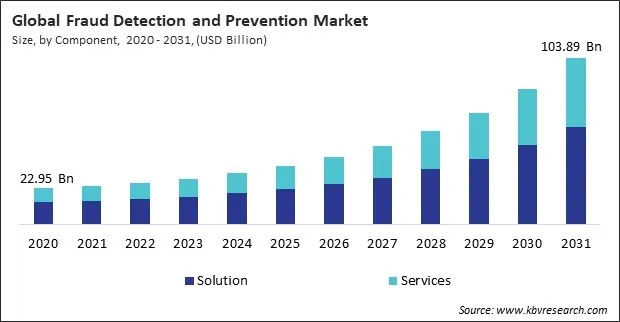
The major strategies followed by the market participants are Partnerships as the key developmental strategy to keep pace with the changing demands of end users. For instance, In February, 2025, ACI Worldwide partners with Banfico to enhance fraud prevention in UK and Europe through Verification of Payee (VOP) and Confirmation of Payee (CoP) services. This collaboration strengthens security against Authorized Push Payment (APP) fraud, aligning with new regulatory compliance mandates. Additionally, In December, 2024, SAS Institute Inc. partnered with Neterium to launch Real-Time Watchlist Screening, an AI-powered AML and CFT compliance solution. The cloud-based tool reduces false positives, enhances detection accuracy, and ensures regulatory compliance, helping banks like Orange Bank improve fraud prevention and risk management.
Based on the Analysis presented in the KBV Cardinal matrix; Oracle Corporation is the forerunners in the Fraud Detection and Prevention Market. In December, 2023, Oracle Corporation partnered with NVIDIA to enhance real-time fraud detection using machine learning on Oracle Cloud Infrastructure (OCI) with NVIDIA Triton Inference Server. This collaboration improves credit card pre-authorization accuracy while maintaining speed, strengthening security in fraud detection and prevention. Companies such as IBM Corporation, Dell Technologies, Inc. and SAP SE are some of the key innovators in Fraud Detection and Prevention Market.
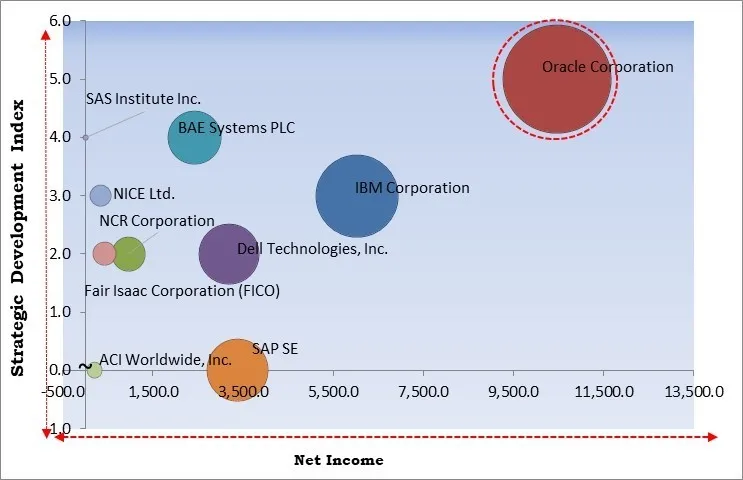
Modern solutions powered by Artificial Intelligence (AI), Machine Learning (ML), and advanced analytics are now essential in detecting and preventing fraud. These technologies facilitate the real-time surveillance and analysis of extensive datasets, thereby assisting organizations in the more precise identification of subtle anomalies and potential threats. AI and ML models can adjust to new fraud trends by continuously learning from fresh data, which lowers false positives and raises fraud detection rates. Hence, as cyber threats become more advanced and costly, organizations must prioritize intelligent fraud detection systems to protect their assets, safeguard customer data, and ensure compliance in an increasingly digital world.
Machine learning models continuously evolve and adapt to new fraud patterns, making them highly effective against threats such as AI-powered fraud schemes, synthetic identity fraud, and automated bot attacks. These systems can detect subtle anomalies that human analysts might overlook, ensuring businesses stay ahead of fraudsters. Furthermore, deep learning methods like neural networks improve the capacity to identify intricate fraud patterns that conventional detection systems could miss. Therefore, advancements in AI and ML are enhancing the speed, accuracy, and efficiency of fraud detection systems, supporting the expansion of the market.
Organizations may face challenges maintaining data consistency and accuracy when integrating new FDP tools with multiple data sources. Without a well-planned and executed integration strategy, there can be issues such as data silos, delayed information processing, and incomplete analysis, which undermine the effectiveness of fraud detection efforts. Additionally, the integration process often requires significant involvement from IT teams and external consultants, further increasing the overall costs and complexity of deployment. Thus, the fraud detection and prevention market's expansion are substantially impeded by the intricate nature of integrating these systems with existing technologies.
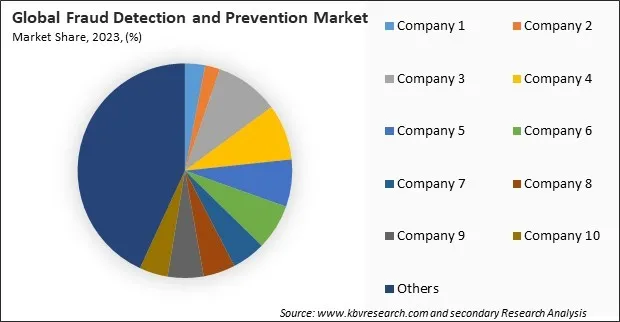
The leading players in the market are competing with diverse innovative offerings to remain competitive in the market. The above illustration shows the percentage of revenue shared by some of the leading companies in the market. The leading players of the market are adopting various strategies in order to cater demand coming from the different industries. The key developmental strategies in the market are Acquisitions, and Partnerships & Collaborations.
Free Valuable Insights: Global Fraud Detection and Prevention Market size to reach USD 103.89 Billion by 2031
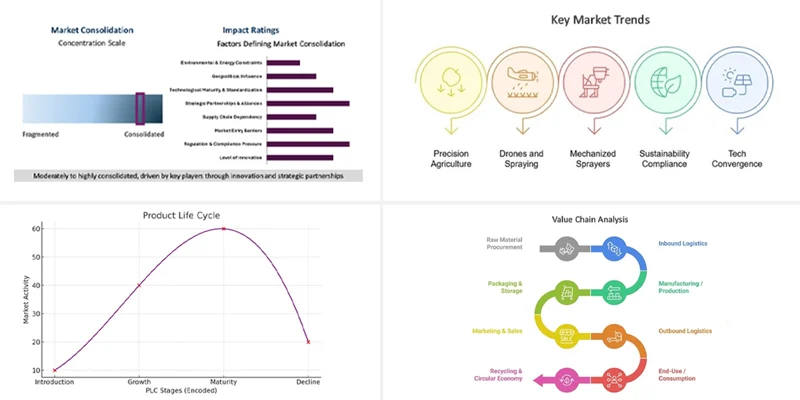
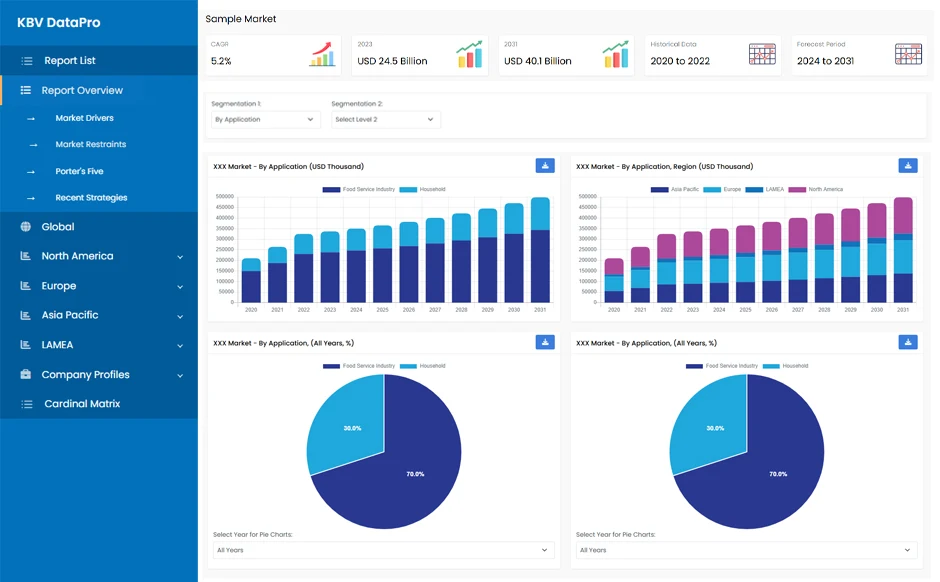
Based on component, the market is bifurcated into solution and services. The services segment procured 39% revenue share in the market in 2023. Professional services, including consulting, system integration, and training, are frequently necessary for organizations that are transitioning to more advanced solutions in order to customize these technologies to specific requirements. Managed services are also gaining traction, offering continuous monitoring, real-time threat intelligence, and incident response to help businesses stay ahead of evolving fraud tactics. Furthermore, many companies lack in-house expertise in fraud prevention and cybersecurity, making them reliant on external service providers to optimize the performance and effectiveness of their fraud detection strategies.
On the basis of organization, the market is classified into large enterprises and SMEs. The large enterprises segment acquired 69% revenue share in the market in 2023. These organizations handle vast volumes of sensitive data and financial transactions across multiple channels, making them attractive targets for cybercriminals. Large enterprises invest heavily in advanced fraud detection and prevention solutions that leverage artificial intelligence (AI), machine learning (ML), and real-time analytics to mitigate these risks. Additionally, strict regulatory compliance requirements and the need to protect their brand reputation compel large organizations to adopt comprehensive, end-to-end fraud prevention frameworks and dedicated security teams.
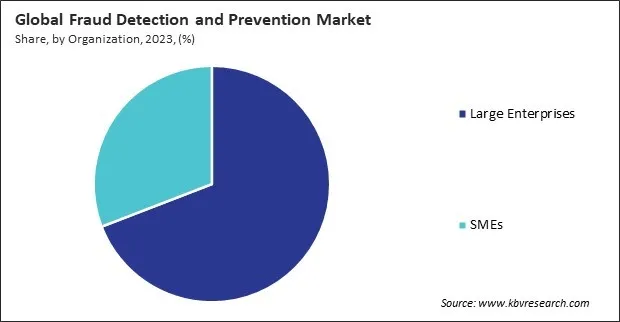
By solution type, the market is segmented into fraud analytics, authentication, and governance, risk, & compliance. The fraud analytics segment witnessed 59% revenue share in the market in 2023. The fraud analytics segment is driven by the increasing need for real-time, data-driven insights to detect and prevent sophisticated fraud schemes. Advanced analytics solutions enable businesses to identify complex fraud patterns, predict fraudulent activities, and reduce false positives. In high-risk industries such as banking, financial services, insurance, and e-commerce, fraud analytics has become an indispensable instrument for proactive fraud management due to its capacity to analyze historical data and reveal concealed risks.
Based on services type, the market is divided into professional services and managed services. The professional services segment procured 54% revenue share in the market in 2023. The segment is primarily driven by the increasing complexity of fraud detection and prevention solutions, which require specialized expertise for successful implementation and optimization. To make sure the FDP solutions are customized to their specific requirements and smoothly incorporated into their current IT infrastructure, organizations—especially large enterprises—rely on professional services for advising, system integration, deployment, and staff training. The demand for expert-led risk assessment and customized fraud prevention strategies further propels the growth of professional services in the market.
On the basis of application, payment fraud, identity theft, money laundering, and others. The identity theft segment witnessed 25% revenue share in the market in 2023. The segment is driven by the rising incidents of data breaches and cyberattacks that compromise sensitive personal information, including social security numbers, financial details, and login credentials. As organizations digitize their customer interactions and adopt remote onboarding processes, the risk of identity fraud has escalated. Identity theft has serious consequences, including account takeovers, fraudulent transactions, and reputational damage.
By vertical, the market is segmented into BFSI, retail & e-commerce, IT & telecom, government & defense, healthcare, industrial & manufacturing, and others. The retail & e-commerce segment procured 17% revenue share in the market in 2023. The segment is driven by the exponential growth of online shopping and digital payment platforms, significantly increasing the risk of fraudulent activities such as payment fraud, account takeovers, and return abuse. Businesses are investing in sophisticated fraud detection solutions that are propelled by AI and machine learning in order to safeguard customer data and provide seamless digital experiences. The rising number of fraudulent chargebacks, fake accounts, and promotion abuse incidents pushes retailers to implement fraud prevention systems to analyze customer behavior in real-time and identify suspicious patterns.
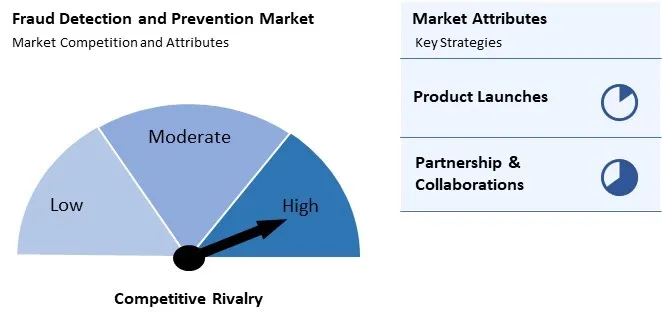
The fraud detection and prevention market is becoming increasingly competitive due to advancements in AI-driven analytics, machine learning, and behavioral biometrics. Real-time fraud detection powered by deep learning and predictive analytics is improving accuracy and reducing false positives. Innovations in blockchain technology, risk-based authentication, and automated anomaly detection are enhancing security across digital transactions. The rise of cloud-based fraud prevention solutions and adaptive AI models is enabling scalable and efficient threat mitigation. As cyber threats grow in complexity, competition is driving continuous innovation in real-time monitoring, automated risk assessment, and multi-layered security frameworks.
Region-wise, the market is analyzed across North America, Europe, Asia Pacific, and LAMEA. The North America segment recorded 37% revenue share in the market in 2023. Countries like the United States and Canada have stringent regulatory frameworks such as the Gramm-Leach-Bliley Act (GLBA), Payment Card Industry Data Security Standard (PCI DSS), and Anti-Money Laundering (AML) compliance requirements, compelling businesses to adopt robust fraud prevention technologies. Additionally, the region’s early adoption of advanced technologies like artificial intelligence (AI), machine learning (ML), and big data analytics for fraud detection, along with the presence of major FDP solution providers, contributes significantly to the market’s growth in North America.
| Report Attribute | Details |
|---|---|
| Market size value in 2023 | USD 24.84 Billion |
| Market size forecast in 2031 | USD 103.89 Billion |
| Base Year | 2023 |
| Historical Period | 2020 to 2022 |
| Forecast Period | 2024 to 2031 |
| Revenue Growth Rate | CAGR of 18.2% from 2024 to 2031 |
| Number of Pages | 380 |
| Number of Tables | 642 |
| Report coverage | Market Trends, Revenue Estimation and Forecast, Segmentation Analysis, Regional and Country Breakdown, Competitive Landscape, Porter’s 5 Forces Analysis, Company Profiling, Companies Strategic Developments, SWOT Analysis, Winning Imperatives |
| Segments covered | Component, Organization, Application, Vertical, Region |
| Country scope |
|
| Companies Included | Dell Technologies, Inc., BAE Systems PLC, IBM Corporation, Oracle Corporation, NICE Ltd., SAP SE, SAS Institute Inc., Fair Isaac Corporation (FICO), NCR Corporation, ACI Worldwide, Inc. |
By Component
By Organization
By Application
By Vertical
By Geography
This Market size is expected to reach $103.89 billion by 2031.
Increased Sophistication of Cyber Threats are driving the Market in coming years, however, High Implementation and Maintenance Costs restraints the growth of the Market.
Dell Technologies, Inc., BAE Systems PLC, IBM Corporation, Oracle Corporation, NICE Ltd., SAP SE, SAS Institute Inc., Fair Isaac Corporation (FICO), NCR Corporation, ACI Worldwide, Inc.
The expected CAGR of this Market is 18.2% from 2023 to 2031.
The Payment Fraud segment is leading the Market by Application in 2023; thereby, achieving a market value of $41.75 billion by 2031.
The North America region dominated the Market by Region in 2023; thereby, achieving a market value of $36.03 billion by 2031.
Our team of dedicated experts can provide you with attractive expansion opportunities for your business.
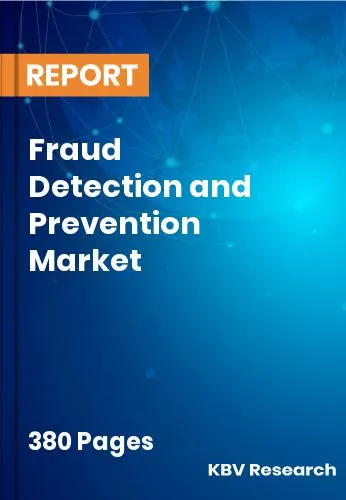
 Drivers
Drivers
 Restraints
Restraints
 Opportunities
Opportunities
 Challenges
Challenges
